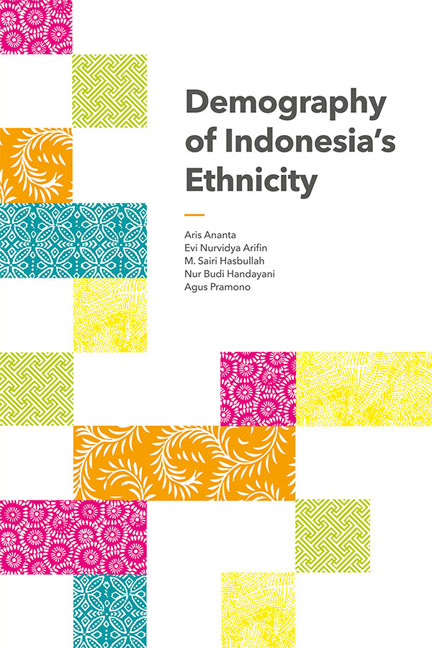Book contents
- Frontmatter
- Contents
- List of Tables
- List of Figures
- Foreword
- Acknowledgements
- 1 CHANGING INDONESIA: An Introduction
- 2 COMPLEXITY OF STATISTICS ON ETHNICITY: Concept, Data and Method of Analysis
- 3 THE NEW CLASSIFICATION: Uncovering Diversity
- 4 ETHNIC DIVERSITY: New Demographic Evidence
- 5 THE FIFTEEN LARGEST ETHNIC GROUPS: Age-Sex Structure and Geographical Distribution
- 6 CHANGE IN SIZE AND COMPOSITION OF ETHNIC GROUPS: Indonesia, 2000–2010
- 7 RELIGION AND LANGUAGE: Two Important Ethnic Markers
- References
- Appendix 1
- Appendix 2
- Index
- About the Authors
6 - CHANGE IN SIZE AND COMPOSITION OF ETHNIC GROUPS: Indonesia, 2000–2010
Published online by Cambridge University Press: 10 October 2017
- Frontmatter
- Contents
- List of Tables
- List of Figures
- Foreword
- Acknowledgements
- 1 CHANGING INDONESIA: An Introduction
- 2 COMPLEXITY OF STATISTICS ON ETHNICITY: Concept, Data and Method of Analysis
- 3 THE NEW CLASSIFICATION: Uncovering Diversity
- 4 ETHNIC DIVERSITY: New Demographic Evidence
- 5 THE FIFTEEN LARGEST ETHNIC GROUPS: Age-Sex Structure and Geographical Distribution
- 6 CHANGE IN SIZE AND COMPOSITION OF ETHNIC GROUPS: Indonesia, 2000–2010
- 7 RELIGION AND LANGUAGE: Two Important Ethnic Markers
- References
- Appendix 1
- Appendix 2
- Index
- About the Authors
Summary
As Indonesia collected information on ethnicity for the first time since the colonial era in the 2000 population census, the discussion on the dynamics of Indonesia's ethnic groups is focused on the period of 2000–2010. However, this chapter also provides a brief discussion relating to the period 1930–2000, as the colonial population census in 1930 collected information on ethnicity. Special caution should be exercised when interpreting the statistics from 1930, especially when comparing with those in 2000 and 2010, as the concepts and coverage of the statistics as well as classification of ethnic groups can be different. Because of space and time limitations, we have concentrated on the dynamics of the fifteen largest ethnic groups in Indonesia according to the 2010 population censuses.
To understand the changes in population numbers, we first need to examine changes in the three basic demographic components: fertility, mortality and migration. The fertility rate has a positive impact on the size of a population by adding to the number of people. On the other hand, the mortality rate has a negative impact by reducing the number of people. Migration can increase or reduce the number of people depending on the flows of out-migration and in-migration. The fertility rate affects the age structure through the youngest population aged 0–4 years old. Mortality and migration can have an impact on all age groups. In addition to these three demographic components, we have checked for any possible differences on the coverage of samples and classifications of ethnic groups over time.
In the next section, we discuss the classifications of ethnic groups in 2000 and compare them with those in 2010. We then compare the coverage of the 2000 and 2010 population censuses, especially the underestimation in the 2000 population census. With this background, this chapter discusses the change of the composition of ethnic groups in Indonesia.
ETHNIC CLASSIFICATION IN 2000
The ethnic groups in 2000, presented in the book, Indonesia's Population: Ethnicity and Religion in a Changing Political Landscape (Suryadinata, Arifin and Ananta 2003), was based on publications by BPS. BPS published the results of the 2000 population census in a series of thirty-one volumes, one volume for each of the thirty provinces and one volume for Indonesia as a whole.
Amongst many other things, this series contains statistics on ethnicity in Indonesia as a whole and within each province.
- Type
- Chapter
- Information
- Demography of Indonesia's Ethnicity , pp. 219 - 252Publisher: ISEAS–Yusof Ishak InstitutePrint publication year: 2014

